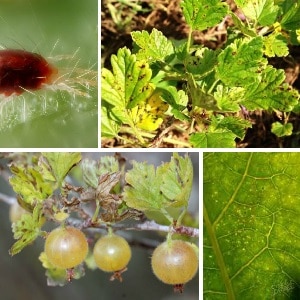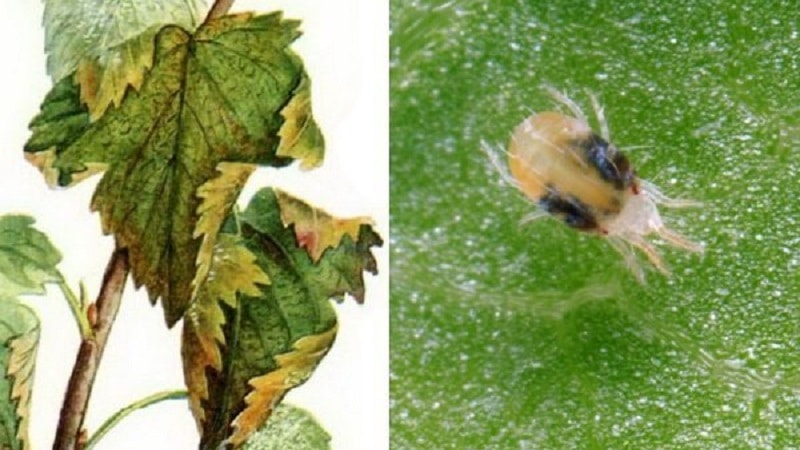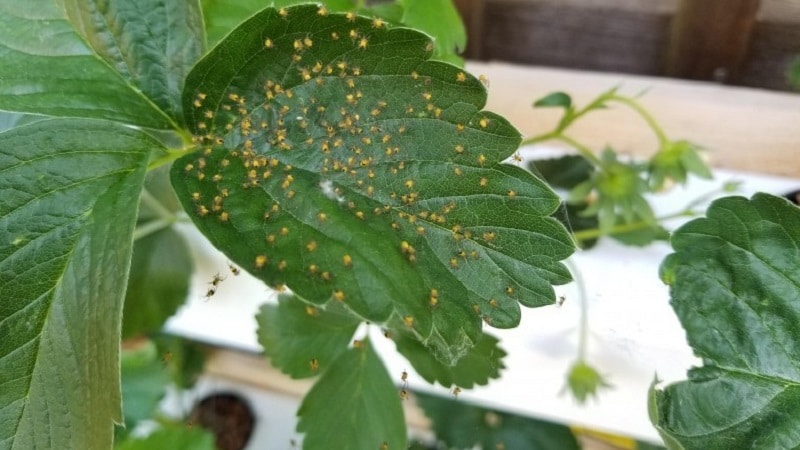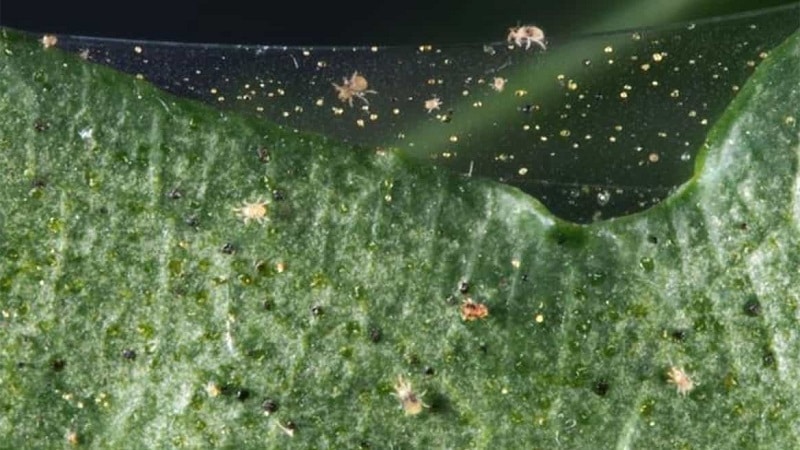How to deal with spider mites on gooseberries easily and effectively
Spider mites are very small insects. The dimensions of its body are no more than 0.4 mm. It is impossible to see a mite on a gooseberry, but it is easy to detect it by eating leaves and branches. The pest poses a serious threat to plantings, so it is necessary to know measures to combat it and ways to save the crop. How to deal with spider mites on gooseberries, read this article.
Signs of gooseberry damage by spider mites
The insect lives on the reverse side of the leaf, entwining it with a cobweb. At first, it remains invisible, so inexperienced gardeners skip the initial stage of gooseberry damage and do not use gentle methods to kill the mite.
How to recognize
Signs of gooseberry mite damage are as follows:
 the foliage becomes covered with brown spots that resemble small punctures;
the foliage becomes covered with brown spots that resemble small punctures;- yellow and light green specks gradually appear;
- leaves and flowers fall;
- the plant develops poorly;
- in later stages, a large accumulation of silvery webs appears between the leaves;
- a careful examination of the back side of the sheet reveals moving dots of red or yellow color;
- the stems are abundantly covered with black specks - insect excrement.
The pest prefers greenhouse crops with thick, fleshy leaves. Therefore, it is better to plant gooseberries away from garden flowers and shrubs.
Damage caused
Spider mites suck the sap from the plant, causing its tissue to die. Numerous affected areas turn into dry areas. Leaves fall, the ovaries do not form, the crop dies.
There are other reasons why ticks are dangerous:
- becomes a source of viral and fungal diseases;
- spreads gray mold spores;
- reduces gooseberry immunity.
Ticks can safely withstand frost because they overwinter in the soil at great depths. When the air temperature warms up to +12°C, they crawl out, immediately heading towards the young foliage.
Causes
The pest enters gooseberries in the following ways:
- With seedlings brought from the nursery. Before purchasing, experienced gardeners carefully examine the leaves for white or yellow spots. If they are discovered, they refuse such an acquisition.
- With street and purchased substrate. Since the insect hibernates at low temperatures, it remains invisible in the soil mixture.
- With the help of the wind. During strong gusts, the tick safely moves from one bush to another.
- On the gardener's clothes. Having caught on a bush, the summer resident unwittingly becomes the reason for the movement of the insect.
- From neighboring areas. For example, a neighbor shared the shoots of a particular plant and thus transmitted insects.

It is recommended to place a newly purchased seedling in a separate warm place for 2 weeks. If during this time the mite is not detected, the plant is calmly planted on the site.
How to get rid of spider mites on gooseberries
Removal and pest destruction occurs with the help of chemical, folk, mechanical means. Chemicals are most effective if they have been used correctly.
Traditional methods
They are used in the initial stages of gooseberry damage. Popular means remain:
- Garlic tincture. Finely chop 2 heads and add 1 liter of hot water. The container is closed and left for 5 days. Before use, the tincture is diluted with water in a 1:1 ratio. Spray the bushes early in the morning or after sunset, in cloudy weather.
- Onion peel. 100 g of the component is poured into 5 liters of warm water. Insist for 5 days. Strain and spray the gooseberries. Often 3-4 drops of iodine are added to increase the effectiveness of the infusion.
- Soap solution. A bar of soap is finely rubbed and dissolved in water until foam forms. The resulting solution is generously sprayed onto the plants. Pay attention to the back of the leaves. The solution is used a few days before rain.
Traditional methods are used as prophylaxis at any stage of gooseberry development. Choose a cloudy, windless day to prevent burns from occurring on the plant.
Agrotechnical techniques
In the process of fighting spider mites, they provide gooseberries good watering and sprinkling. The pest does not like high humidity, so in hot weather the bushes are watered generously with cool water from a hose. Weeds and new shoots are regularly removed.
Mechanical methods
Every day, the gooseberries are carefully inspected, dry, spotted, curled leaves are removed and destroyed. If the plant is severely damaged and no medications help, it is cut down and burned. After each watering, the soil around the bush is slightly turned over to get rid of fallen mites.
Chemicals
These include insectoacaricides. The drugs require careful use in accordance with the instructions.

Good chemicals are:
- "Aktellik".It is created on the basis of pirimiphos-methyl, therefore it acts on the tick by contact. The insect absorbs the poison, after which it stops digesting food and dies. The drug is diluted in water (2 ml in 2 l) and sprayed on the gooseberries using a spray bottle. One ampoule is enough for 10 sq. m. Treatment is carried out 2 times every 2 weeks. Choose dry, slightly cloudy, windless weather. Be sure to use personal protective equipment.
- "Apollo." Destroys clutches and larvae. Contains the substance clofentezine. The drug can make females infertile. Treatment is carried out by spraying on the bark and stems only during the period of swelling of the buds. Dilute 2 ml in 5 liters of warm water, use 2 times throughout the entire season (spring and autumn).
- "Neoron". Effective against adults, larvae and eggs. Contains the substance bromopropylate. Safe for bees, therefore suitable for use during the flowering period. Retains properties in all weather conditions. Dilute one ampoule in 10 liters of water, and generously treat the leaves and stems with the resulting solution.
Before using any drug, be sure to read the manufacturer’s instructions and advice. Otherwise, there is a risk of death of other garden crops and pollinating insects.
Features of pest control in different periods
During the flowering and fruiting period, it is permissible to use only folk remedies and biological products, since chemicals will seriously harm flowers and pollinating insects.
During the period of bud break and after the end of fruiting, chemicals and preventive measures are used.
How to fight during the period of green berries
During the period of green berries, spraying with infusion of onion peels is used as a control method. Perform agrotechnical practices.During the sprinkling process, make sure that the stream pressure is not strong. Otherwise the berries will end up on the ground.
Preventive measures
The best fight against spider mites is timely preventive work. These include:
- Weeding. The area under the gooseberries is always kept clean, fallen leaves and weeds are removed, and the soil is periodically dug up.
- Trimming and thinning of shoots. Remove deformed, diseased and dry branches.
- Removal affected leaves. Sick foliage will cause oppression of still healthy vegetation.
- Mulching the soil under the bush. A dense layer of mulch created in the fall will prevent the appearance of insects in late spring.
Helpful Tips and Mistakes to Avoid
Any drugs are used when the air temperature warms up to +18°C. In cold weather, the effectiveness of the products is noticeably reduced.
After detecting the first signs of the presence of a tick, the affected areas are removed. This makes it possible to prevent a more serious spread of the pest and associated diseases.
All activities are carried out using personal protective equipment. If precautions are not taken, damage to the skin, eyes and respiratory system may occur.
Gooseberries are covered with cobwebs - what to do
The presence of a large amount of cobwebs indicates a serious stage of gooseberry damage. The use of drugs will not give positive results.

If there is a small accumulation of cobwebs, water the bush with a hose, trying to knock down as many clumps as possible. Diseased branches are cut out. In other cases, the bush is completely dug up.
Interesting things on the site:
How to deal with gooseberry moth
Gooseberry sawfly and methods of combating it
How dangerous are aphids on gooseberries and how to fight them
Conclusion
Spider mites are a dangerous pest not only for gooseberries, but also for other berry crops and trees, so it is better to start fighting immediately after its detection. In the initial stages, drugs and manual methods will help, in the latter stages only cutting down will help.